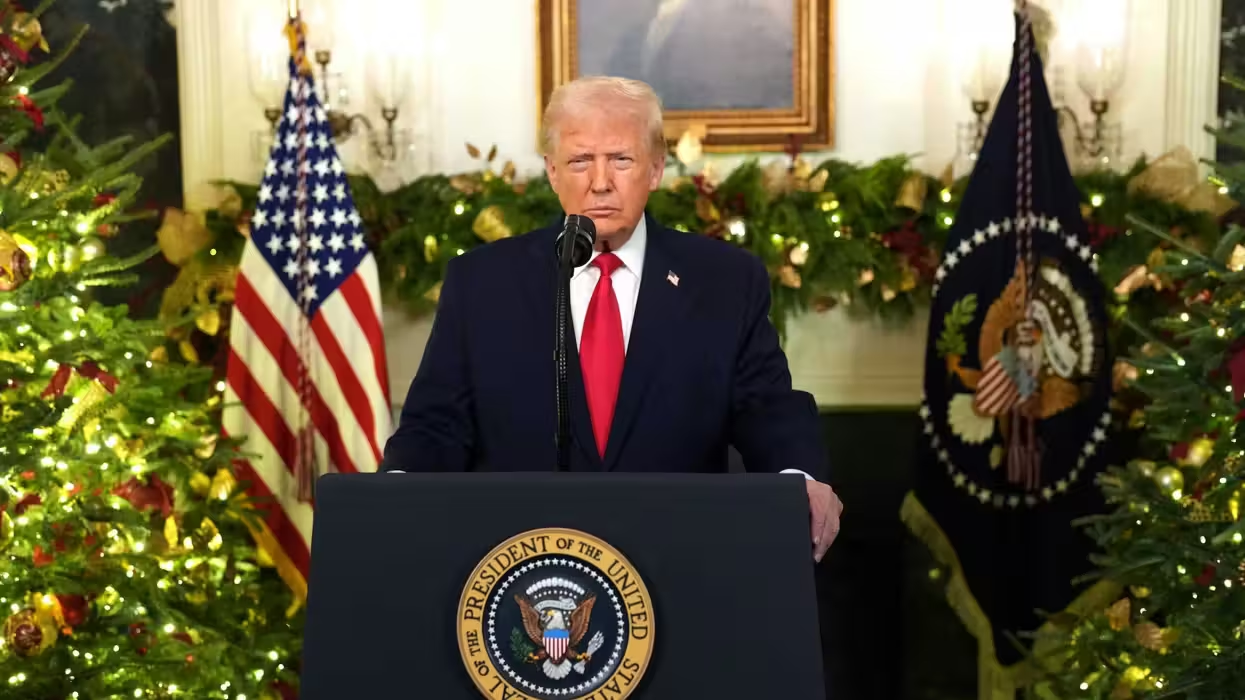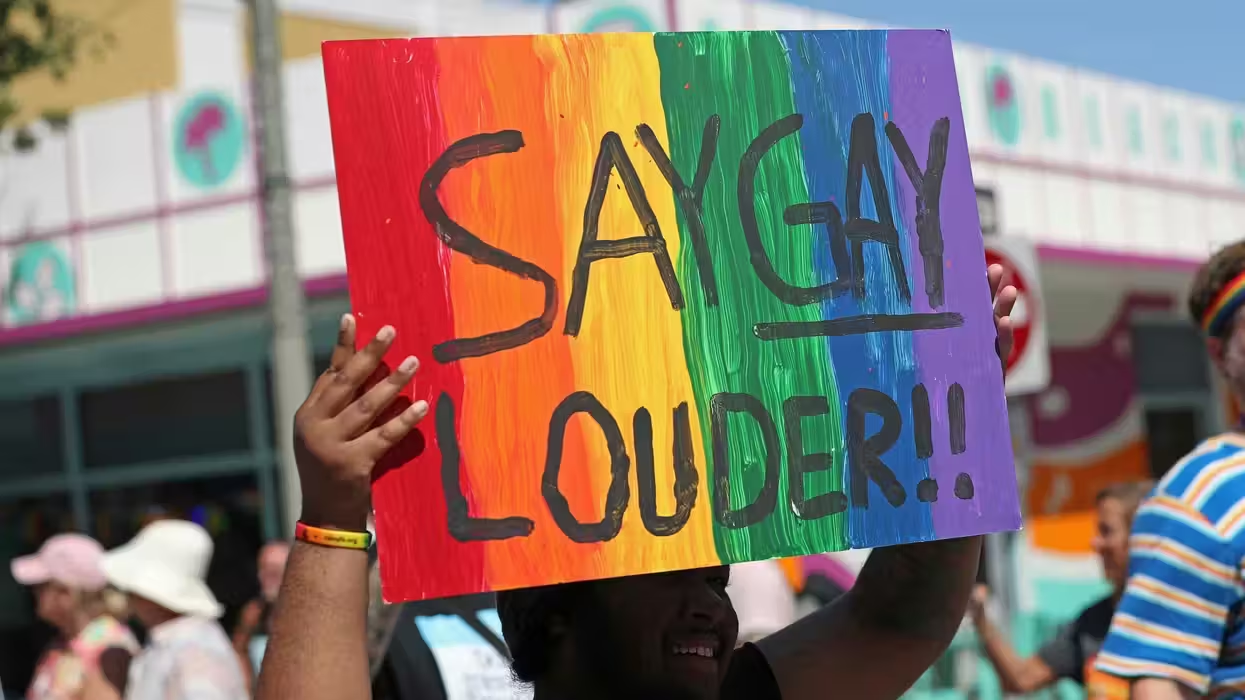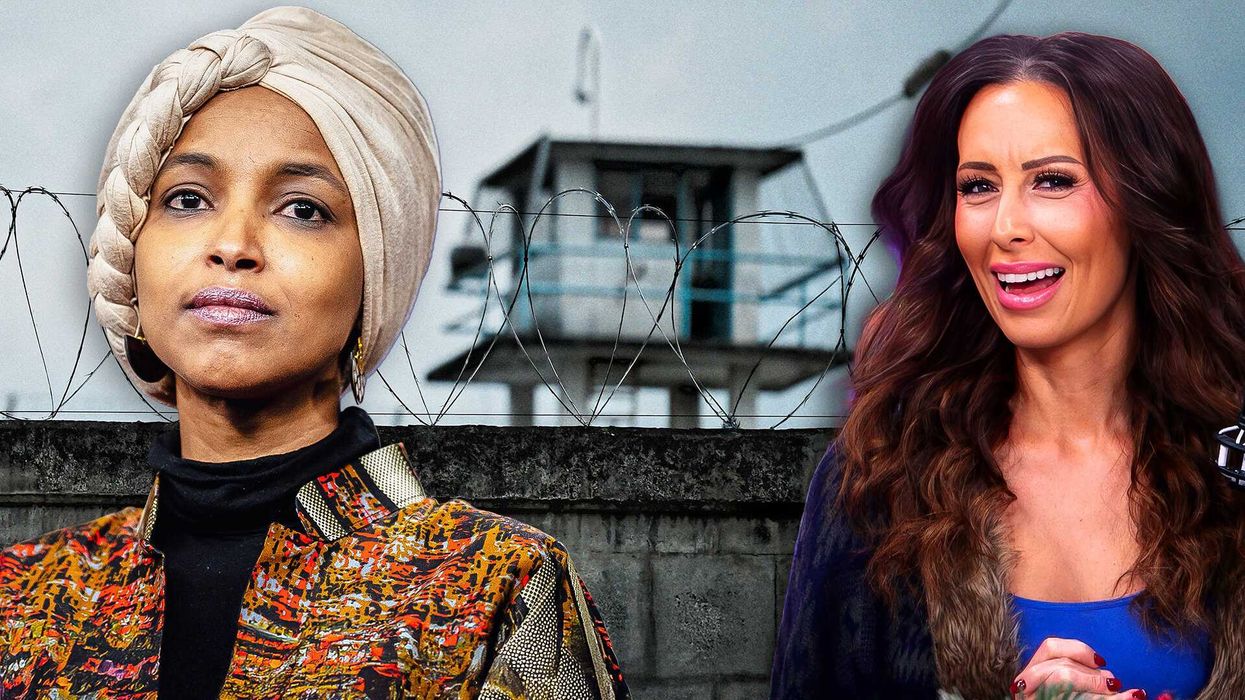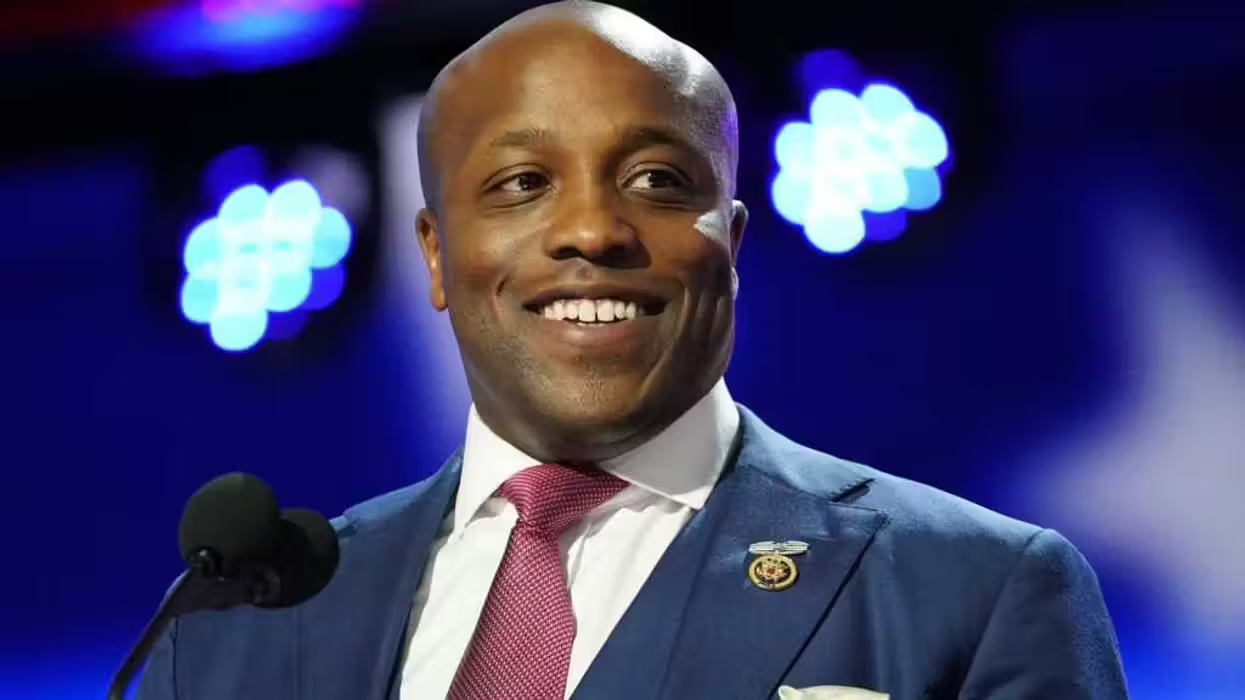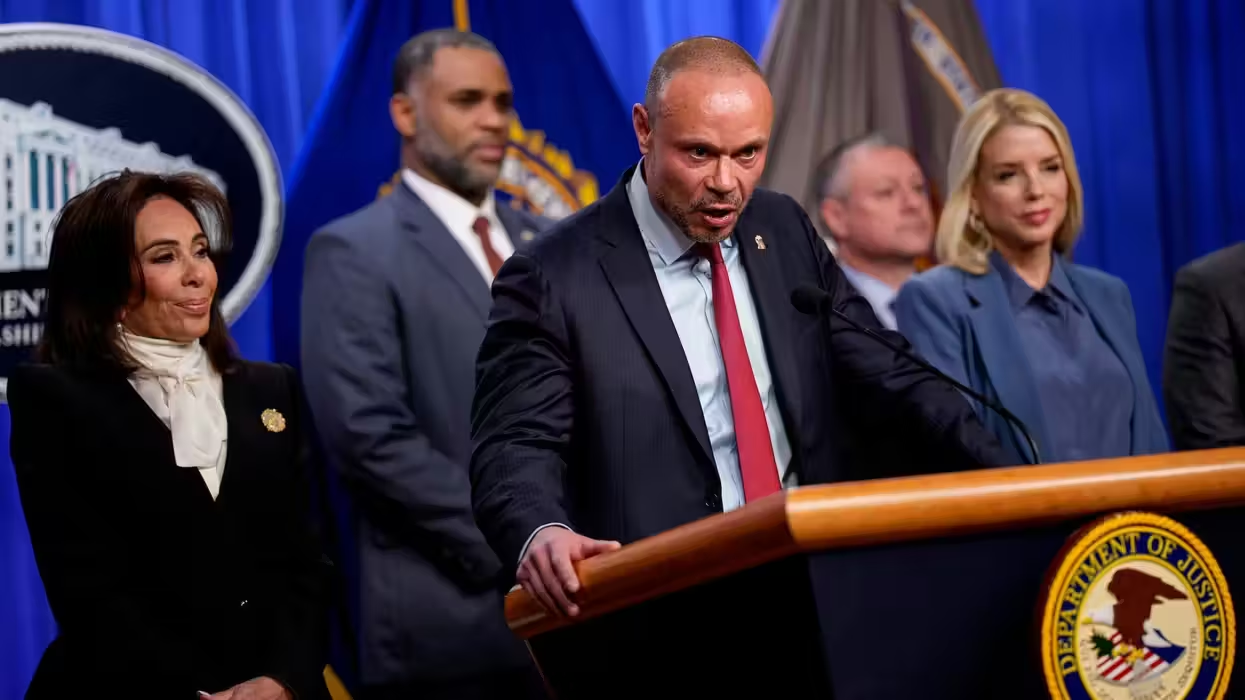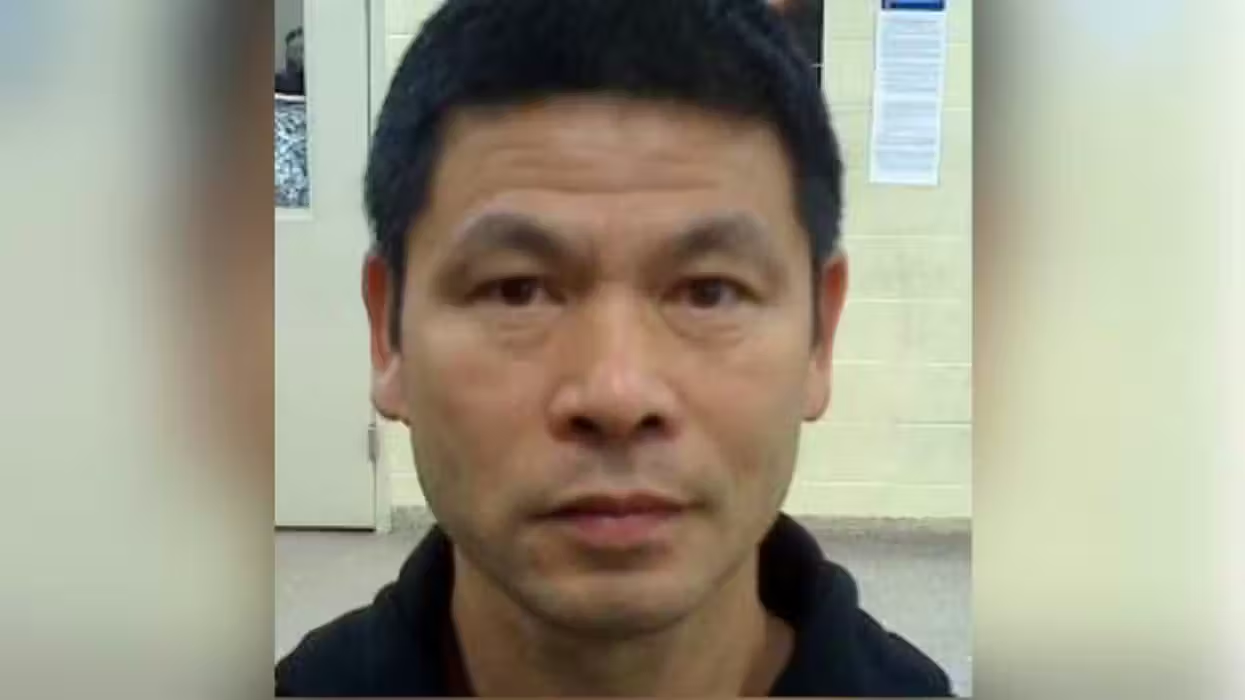VATICAN CITY (TheBlaze/AP) -- Cardinals celebrated a final Mass on Tuesday before sequestering themselves in the Sistine Chapel for the conclave to elect the next pope, seeking to overcome their divisions and rally behind a single man who can lead the 1.2 billion-strong Catholic Church and tend to its many problems.
As a Gregorian chant filled St. Peter's Basilica, the 115 cardinals who will participate in the conclave filed in wearing bright red vestments, many looking grim as if the burden of the imminent vote was weighing on them.
 Tourists walk under heavy rain while a giant screen shows a mass of cardinals on St Peter's square ahead of a conclave on March 12, 2013 at St Peter's square at the Vatican. Cardinals moved into the Vatican on Tuesday as the suspense mounted ahead of a secret papal election with no clear frontrunner to steer the Catholic world through troubled waters after Benedict XVI's historic resignation. Credit: AFP/Getty Images
Tourists walk under heavy rain while a giant screen shows a mass of cardinals on St Peter's square ahead of a conclave on March 12, 2013 at St Peter's square at the Vatican. Cardinals moved into the Vatican on Tuesday as the suspense mounted ahead of a secret papal election with no clear frontrunner to steer the Catholic world through troubled waters after Benedict XVI's historic resignation. Credit: AFP/Getty Images
In his homily, Cardinal Angelo Sodano, dean of the College of Cardinals, called for unity within the church, a not-so-veiled appeal to the cardinal electors to put their differences aside for the good of the church.
"Each of us is therefore called to cooperate with the Successor of Peter, the visible foundation of such an ecclesial unity," Sodano said.
He was interrupted by applause from the pews - not so much from the cardinals - when he referred to the "beloved and venerated" Benedict XVI and his "brilliant" pontificate.
Benedict's surprise resignation - the first in 600 years by a pope - has thrown the church into turmoil and exposed the deep divisions among cardinals who are grappling with whether they need a manager who can clean up the Vatican's dysfunctional bureaucracy or a pastor who can inspire Catholics at a time of waning faith.
A BREAKDOWN OF WHERE THE CARDINALS COME FROM
In the papal conclave that begins Tuesday, 115 cardinals will elect the next pope. All of them were created either by Benedict XVI or Pope John Paul II, ensuring that whoever is chosen will follow in their conservative line. Here's their geographic distribution:
---
EUROPE: 60 electors, or more than half the bloc. Italy alone claims 28, followed by Germany with six.
NORTH AMERICA: 14 electors, with 11 from the United States and three from Canada.
LATIN AMERICA: 19 electors. Brazil has the most with five.
AFRICA: 11 electors, with Nigeria counting two.
ASIA: 10 electors, with India counting five.
OCEANIA: One elector: Sydney Cardinal George Pell.
THE FIRST VOTE MAY BE HELD TODAY
In the afternoon, the 115 cardinal electors will file into the frescoed Sistine Chapel singing the Litany of Saints, a hypnotic chant imploring the intercession of saints to help them choose a pope. They will hear a meditation by an elderly Maltese cardinal, take an oath of secrecy, then in all probability cast their first ballots.
Assuming they vote, the first puffs of smoke should emerge from the chapel chimney by 8 p.m. (1900 GMT; 3 p.m. EDT) - black for no pope, white if a pope has been chosen.
The conclave is taking place amid more upheaval and uncertainty than the church has seen in decades: There's no front-runner, no indication how long voting will last and no sense that a single man has what it takes to be pope.
 American Cardinals walk to a bus to take them from the North American College to St. Peter's Basilica where a Pro Eligendo Romano Pontifice Mass will be celebrated before they enter the Conclave to decide who the next pope will be on March 12, 2013 in Rome, Italy. Cardinals are set to enter the conclave to elect a successor to Pope Benedict XVI after he became the first pope in 600 years to resign from the role. The conclave is scheduled to start in the afternoon inside the Sistine Chapel and will be attended by 115 cardinals as they vote to select the 266th Pope of the Catholic Church. Credit: Getty Images
American Cardinals walk to a bus to take them from the North American College to St. Peter's Basilica where a Pro Eligendo Romano Pontifice Mass will be celebrated before they enter the Conclave to decide who the next pope will be on March 12, 2013 in Rome, Italy. Cardinals are set to enter the conclave to elect a successor to Pope Benedict XVI after he became the first pope in 600 years to resign from the role. The conclave is scheduled to start in the afternoon inside the Sistine Chapel and will be attended by 115 cardinals as they vote to select the 266th Pope of the Catholic Church. Credit: Getty Images
The buzz swirled around Cardinal Angelo Scola, an Italian seen as favored by cardinals hoping to shake up the powerful Vatican bureaucracy, and Brazilian Cardinal Odilo Scherer, a favorite of Vatican-based insiders intent on preserving the status quo. Other names included Canadian Cardinal Marc Oullet, who heads the Vatican's powerful office for bishops, and American Cardinal Timothy Dolan.
Going into the vote, cardinals offered wildly different assessments of what they're looking for in the next pontiff and how close they are to a decision. It was evidence that Benedict XVI's surprise resignation has continued to destabilize the church leadership and that his final appeal for unity may go unheeded, at least in the early rounds of voting.
A few cardinals also sent their last tweets before entering the conclave, which forbids communication with the outside world.
"Heavenly Father, guide our hearts and grant us wisdom and strength tomorrow," Ghanaian Cardinal Peter Turkson, considered to have an outside chance to be pope, tweeted late Monday.
A LOOK AT CONCLAVES OVER THE PAST 100 YEARS
Over the past century, no conclave has lasted more than five days and the fastest vote was for Pope Pius XII. Twice prelates from North America missed the vote because they couldn't get to Rome in time, and a Hungarian cardinal sat out two conclaves because he was holed up in the U.S. Embassy in Budapest seeking asylum.
A look at a century of conclave balloting.
---
July 31-Aug. 4, 1903: Italian Cardinal Giuseppe Sarto (Pius X) elected on seven ballots over four days. Sixty-two of 64 cardinals participated.
---
Aug. 31-Sept. 3, 1914: Italian Cardinal Giacomo della Chiesa (Benedict XV) elected on 10th ballot on third day. Fifty-six of 65 cardinals participated. Cardinals from Boston, Baltimore and Quebec arrived after the election.
---
Feb. 2-6, 1922: Italian Cardinal Achille Ratti (Pius XI) elected on 14th ballot on fifth day. Fifty-three of 60 cardinals participated. Cardinals from Boston, Philadelphia and Quebec arrived too late.
---
March 1-2, 1939: Italian Cardinal Eugenio Pacelli (Pius XII) elected on third ballot on second day. All 62 cardinals participated.
---
Oct. 25-28, 1958: Italian Cardinal Angelo Roncalli (John XXIII) elected on 11th ballot on fourth day. Fifty-one of 53 cardinals participated. Cardinal Jozsef Mindszenty of Hungary had taken asylum in the U.S. Embassy in Budapest, and Yugoslav Cardinal Alojzije Stepinac was under house arrest.
---
June 19-21, 1963: Italian Cardinal Giovanni Battista Montini (Paul VI) elected on sixth ballot on third day. Eighty of the 88 cardinals participated. Mindszenty was still in U.S. Embassy asylum.
---
Aug. 25-26, 1978: Italian Cardinal Albino Luciano (John Paul I) elected on fourth ballot on second day. A total of 111 cardinals from 49 nations and territories took part and three were absent because of illness; 15 cardinals could not join under new rule limiting vote age to under 80.
---
Oct. 14-16, 1978: Polish Cardinal Karol Wojtyla (John Paul II) elected on eighth ballot on third day to become first non-Italian pope since Adrian VI (1522-1523). A total of 111 cardinals from 49 nations and territories took part.
---
April 18-19, 2005: German Cardinal Joseph Ratzinger (Benedict XVI) elected on fourth ballot on second day. A total of 115 cardinals from 52 nations and territories took part.
HOW TECHNOLOGY WILL IMPACT THE CONCLAVE
It's not only the cardinals who are using technology to communicate about the conclave. The general public, too, has ben invited to use new media tools to keep updated.
A Catholic organization has set up a website that lets people register to receive a text or email notification when a pope has been selected.
While the process of selecting a new pope is as old as the ages, there are enough changes to the media to make the last papal conclave - in 2005 - seem like ancient history.
 Screen shot from PopeAlarm.com
Screen shot from PopeAlarm.com
The text service was set up by the Fellowship of Catholic University Students, or FOCUS, and had proven so popular with more than 40,000 respondents that the popealarm website said Monday it was accepting no new registrants. The site hopes to increase its capacity before the cardinals begin voting, said Jeremy Rivera, spokesman for the Christian campus ministry.
"When the smoke goes up, you'll know what's going down" is the website's motto.
FOCUS paid nearly $10,000 to set up the free service, figuring it was good publicity. Now the group's leaders are sifting through co-sponsorship offers from other organizations impressed with the amount of online traffic it has generated and hoping for their own exposure, he said.
Another new website assigns interested people one of the voting cardinals at random to pray for him as he deliberates on a new pope. More than 450,000 people had signed up by Monday.
For more about the conclave voting process, click here.
--
Other Must-Read Stories:

 Tourists walk under heavy rain while a giant screen shows a mass of cardinals on St Peter's square ahead of a conclave on March 12, 2013 at St Peter's square at the Vatican. Cardinals moved into the Vatican on Tuesday as the suspense mounted ahead of a secret papal election with no clear frontrunner to steer the Catholic world through troubled waters after Benedict XVI's historic resignation.
Tourists walk under heavy rain while a giant screen shows a mass of cardinals on St Peter's square ahead of a conclave on March 12, 2013 at St Peter's square at the Vatican. Cardinals moved into the Vatican on Tuesday as the suspense mounted ahead of a secret papal election with no clear frontrunner to steer the Catholic world through troubled waters after Benedict XVI's historic resignation. 
